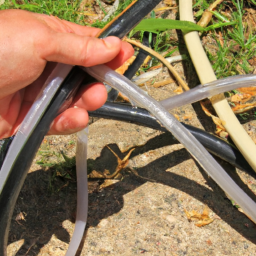How To Patch A Garden Hose
Table of Contents []
How To Patch A Garden Hose
Introduction
Fixing a garden hose may seem like a daunting task. But if you take the time to diagnose and locate the source of the leak, you can patch it up in no time. Taking preventive measures will help prevent further damage and will give you peace of mind. In this article, we will discuss 8-12 essential topics on how to patch a garden hose in a safe and effective manner. This includes topics on how to identify the source of the leak, the types of material available for repair, the tools needed, the step-by-step process, safety-conscious measures, preventive techniques, maintenance tips, and finally, some wrap-up advice.
Types of Material Available for Repair
One of the first decisions to make when patching a garden hose is to decide what type of material to use for the repair. There are several materials available, but some are better suited for certain hose types than others.
For example, plastic patching tape is the most common type of material used for repairing garden hoses. It is a highly effective and cost-effective solution that can be applied quickly and easily. It is waterproof and won't scratch or damage the hose. Another great option is self-fusing' silicone tape. This tape comes in a roll and is designed to be cross-wrapped around the leak for a permanent fix. It has excellent resistance to harsh temperatures and is environmentally friendly. Lastly, a permanent repair may require the use of a hose-end repair kit. These kits come in various sizes and usually include epoxy adhesives, clamps, and various mounting hardware.
Tools Needed
In order to successfully patch a garden hose, some essential tools will need to be on hand. An adjustable pair of pliers or cutters will be necessary for cutting away a bad section of hose and measuring the length of a new piece that needs to be inserted. A tape measure may also be necessary for measuring the hose. A screwdriver or drill is often needed for attaching a hose-end repair kit. The necessary patches or tape for repairing the hose, either plastic patching tape or self-fusing silicone tape, will also need to be on hand. Finally, some form of lubricant or solvent will be needed to ensure a proper seal.
Step-by-Step Process
The process of patching a garden hose can be broken down into a few simple steps. First, identify and isolate the source of the leak. This can be done using a pair of pliers and possibly a knife. Once the source is identified, cut away the damaged section of hose using adjustable cutters. The length of the cut-out piece will be the same length that is required when inserting a new piece of hose.
Next, insert a new piece of hose into the existing section and make sure that it is properly aligned. Finally, apply a waterproof adhesive or tape onto the external side of the hose to hold the repair together. Once the adhesive has dried, make sure to double-check the repair is secure before testing it with water.
Safety-Conscious Measures
Safety should always be at the forefront of any repair project. To avoid any unwanted accidents, always wear protective gear such as glasses, gloves, and a dust mask. Before testing the repaired hose with water, always make sure to disconnect the hose from the tap. When using any kind of solvent or lubricant, it is important to read and follow the directions provided on the label.
Preventive Techniques
In addition to periodic checks and repairs, the best way to ensure proper functioning of a garden hose is to follow preventive measures. For instance, storing a garden hose in a dry and well-ventilated area will help reduce the potential for leaks. Additionally, maintaining an optimal temperature for the hose will help protect the hose from extreme temperatures. If possible, always keep the hose away from any sharp objects as this can significantly increase the potential for early wear and tear.
Maintenance Tips
Every few months, a garden hose should be cleaned and inspected for any signs of wear and tear. This includes checking the surface of the hose for any cracks, holes, or perforations. If any damage is identified, it is important to replace the hose with a new one. And it is equally important to keep the hose clean and free from any debris. This can be accomplished by rinsing the hose with fresh water.
Summary
This article detailed 8-12 essential topics on how to patch a garden hose in a safe and effective manner. This includes topics such as the types of material available for repair, the tools needed, the step-by-step process, safety-conscious measures, preventive techniques, and maintenance tips. Patches, tapes, and repair kits can all be used to patch a garden hose and preventive measures should be taken to ensure long life and proper functioning of the hose. Remember to always wear protective gear and follow the instructions provided by the manufacturer. With the proper attention and care, a garden hose can be easily patched up and functioning in no time.

Previous Page
Next Page
